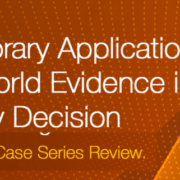APPROACHES TO RWE REGULATORY SUBMISSIONS
Regulatory submissions that involve the submission of RWD can come from data sources that routinely collect health-related information such as claims data, electronic health records, patient reported outcomes (questionnaires and devices), registries, as well as public and private databases. The use of RWE implies the analyses of RWD through applied research methods, such as for historical controls, or other types of analyses using records that were initially collected from sources other than randomized clinical trials. It is important to first target an opportunity where the use of RWE will add to the “totality of evidence.” The role of RWD and RWE has been especially useful for rare diseases as well as for the expansion of labeling to a more broad or newly defined sub-population, and the evolution of procedural medical device techniques. Using a “totality of evidence” approach, one can determine if the new evidence from RWD sources or RWE analyses can add to the existing evidence to create a new evidence package that has value from a clinical and regulatory perspective.
A White Paper prepared in December 2019 by the Duke Margolis Center for Health Policy5 examined non-traditional study designs which have used RWE, including open-label, single-arm studies, retrospective observational and case series, retrospective cohort studies using RWD sources, non-inferiority studies, RWE-generated historical controls, the use of concurrent control groups, and the use of post-market surveillance and registry data. Table 1 is an adapted summary of examples of approvals and labeling changes for drugs using evidence generated from these non-traditional studies. This article discusses three pharmaceutical case examples in this communication: Ibrance for male breast cancer, Invega Sustenna for schizoaffective disorder and Brineura for treatment of a form of Batten disease. The article also examines the label expansion of a medical device based on RWE to include a minimally-invasive approach to aortic valve replacement using Transcatheter Aortic Valve Replacement (TAVR).
Ibrance (Pfizer) for Male Breast Cancer Indication
Ibrance (Palbociclib) was approved for metastatic breast cancer in 2019. The approval was based on two large randomized controlled trials (the PALOMA studies) in women and supported by clinical pharmacology and non-clinical toxicology studies. Evidence for clinical benefit in male breast cancer was noted from post-marketing reports, insurance claims data and electronic health records. Male breast cancer is a rare condition with a high unmet need for treatment; there were approximately 2,500 new cases and 500 deaths in 2019. The FDA submission included evidence derived from RWD sources including: the IQVIA insurance database, Flatiron Health breast cancer database, and the Pfizer global safety database. The FDA noted in its approval letter that “Given the extensive established efficacy and safety of the use of Palbociclib in women observed in randomized controlled trials, the additional RWE data provided in this application for the use in men, modest as it is, does support the expansion of the Palbociclib indication to provide for the treatment of men with metastatic breast cancer.”6






